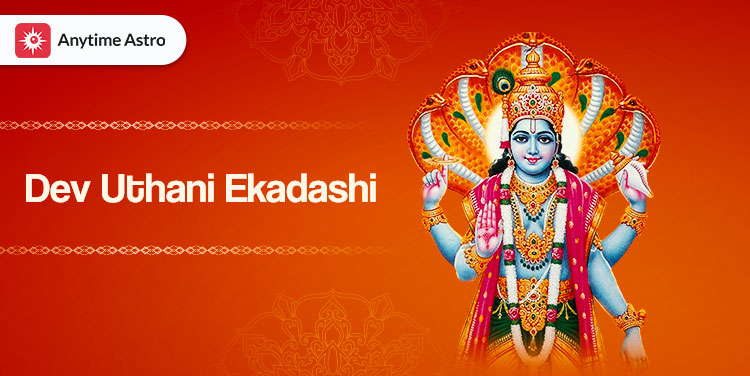


On November 12, 2024, Hindus around the world will celebrate Dev Uthani Ekadashi, a day that marks the awakening of Lord Vishnu from his divine sleep. This day, also known as Dev Prabodhini Ekadashi, is believed to bring solutions to problems and create auspicious conditions, particularly for those seeking successful marriages. According to the Shiva Purana, after defeating the demon Shankhasura, Lord Vishnu retired for four months, and upon awakening, he resumed his duties as the preserver of the universe. The day is celebrated with devotion and rituals, and while the beliefs and guidance may vary, it is recommended to consult a qualified expert before considering or implementing any information or belief discussed.
Dev Uthani Ekadashi: Awakening of Lord Vishnu
Background:
Dev Uthani Ekadashi is a significant Hindu festival that marks the awakening of Lord Vishnu from his four-month slumber during Chaturmas, the monsoon period. It is believed that on this day, Lord Vishnu rises from his abode in the ocean of milk and resumes his duties as the preserver of the universe.
The festival is also known as Prabodhini Ekadashi, meaning the "Awakening Ekadashi." It is celebrated on the eleventh day (Ekadashi) of the bright fortnight of Kartik month (October-November). In 2024, Dev Uthani Ekadashi will fall on November 12th.
Rituals and Beliefs:
Dev Uthani Ekadashi is observed with devotion and rituals across India. Devotees observe fasting from sunrise to sunset, worship Lord Vishnu, and perform Satsang (religious gatherings). It is believed that fasting on this day brings forgiveness of sins, removes obstacles, and grants blessings.
According to the Shiva Purana, after defeating the demon Shankhasura, Lord Vishnu retired to the ocean of milk for a four-month sleep. During this time, the universe was without its protector, and evil forces prevailed. Upon awakening, Lord Vishnu resumed his role, bringing back order and peace to the world.
Significance:
Dev Uthani Ekadashi is particularly auspicious for those seeking successful marriages. It is believed that performing certain rituals on this day can bring about suitable marriage proposals and remove obstacles in the path of marriage. The day also marks the beginning of the wedding season in India.
Top 5 FAQs and Answers:
1. When is Dev Uthani Ekadashi celebrated in 2024? Answer: November 12, 2024.
2. What is the significance of Dev Uthani Ekadashi? Answer: It marks the awakening of Lord Vishnu and the resumption of auspicious activities after the monsoon season.
3. What are the rituals associated with Dev Uthani Ekadashi? Answer: Fasting, worshipping Lord Vishnu, performing Satsang, and offering Tulsi (basil) leaves.
4. What is the benefit of fasting on Dev Uthani Ekadashi? Answer: It is believed to bring forgiveness of sins, remove obstacles, and grant blessings.
5. Is Dev Uthani Ekadashi considered an auspicious day for marriage? Answer: Yes, it is considered an auspicious day for performing marriage rituals and seeking successful marriage proposals.

As India celebrates Diwali today, devotees are preparing to perform the auspicious Lakshmi Puja to seek the blessings of the goddess of wealth and prosperity. The most auspicious timings for the puja have been revealed, falling between 7:25 pm and 8:31 pm. This article provides a city-wise breakdown of the muhurat and also highlights other important details for performing the puja on this special day.

Narak Chaturdashi, also known as Chhoti Diwali, is more than just a fancy decoration ritual. It holds deep significance in Hindu beliefs, honoring Lord Yama and seeking protection from negative energies in the coming year. The arrangement and number of diyas have symbolic meanings and a specific auspicious time for lighting them on this particular day. The act of lighting diyas on Narak Chaturdashi is a powerful chain of emotions that brings forth resilience, wisdom, and inner strength, leading to harmony and auspiciousness in the household.

On the occasion of Deepotsav, Ayodhya made history by setting two new Guinness World Records - lighting over 26 lakh diyas and hosting the largest-ever Saryu aarti. The event was organized by the Uttar Pradesh Tourism Department and the Ayodhya District Administration, with the participation of over 30,000 volunteers. The Guinness World Records officials commended the efforts and stated that it was an honor to witness such a grand and spectacular display. The city of Ayodhya also celebrated Diwali with a drone show and a Ram Leela performance, making the event even more special.

As the country gears up for the festival of lights, various states have announced school holiday dates to allow students and teachers to participate in Diwali and other related celebrations. Some states are offering a five-day break, while others have extended the off period to almost two weeks. This break not only gives students time to celebrate with family, but also allows for preparation and participation in other cultural and religious festivities.

The Imperial War Museum has embarked on a groundbreaking project, using technology to bring historical archives to life and give a voice to the past. Through the use of cutting-edge techniques, the museum is unlocking stories that have long been silent, shedding new light on the events of the past. This innovative approach is providing a unique perspective on history and shaping our understanding of global events.

Dhanteras, also known as the festival of lights, falls on October 18th this year. To celebrate this auspicious day, people follow various rituals such as worshipping Lord Dhanvantari and Kubera and lighting diyas in the name of Yamaraj. According to traditional beliefs, performing these rituals with a pure heart and following prescribed customs can bring wealth, prosperity, and happiness into one's household. However, there is no scientific evidence to support these beliefs.

The much-awaited festival of Diwali is just around the corner and preparations are already underway. According to the 2025 calendar, the Lakshmi Puja Muhurat for Diwali has been announced to be on October 20. This auspicious day brings with it an opportunity for families to gather and worship Goddess Lakshmi for blessings of prosperity and good luck. The five-day festival, beginning with Dhanteras and ending with Bhai Dooj, each day holds a significant spiritual meaning and is eagerly awaited by devotees.

Just days before the festival of lights, Delhi-NCR was brought to a standstill as severe traffic congestion struck the region. The festive rush, combined with ongoing roadwork and market zones bustling with Diwali shoppers, resulted in major delays and gridlock across the city. In response, the Delhi Traffic Police issued a strong advisory and took several measures to handle the traffic overload and prioritize safety. As the weekend and Diwali shopping continue, commuters are reminded to plan their journeys carefully to avoid getting stuck in the chaos.

As festive celebrations pick up pace in the national capital, Delhi Traffic Police is urging people to plan their travel in advance due to widespread traffic disruptions. Ongoing road repairs and broken sewer lines have added to the traffic woes, prompting the police to cancel leaves and deploy personnel to handle the growing Diwali rush. Many major intersections have experienced bottlenecks, and motorists are advised to follow diversion routes and check live updates before stepping out.

Diwali, the festival of lights, celebrates good over evil and the victory of light over darkness. This year, Diwali falls on October 20, with Lakshmi Puja being the main ritual dedicated to Maa Lakshmi, the goddess of wealth. The Amavasya Tithi, which marks the new moon, is considered the most auspicious time for the Puja and falls between 3.44 pm on October 20 and 5.54 pm on October 21. Diwali is celebrated across India and in many countries with Indian-origin communities, with families coming together to light diyas, offer prayers, and prepare sweets and offerings for the goddess. Different cities have their own auspicious timings for the Puja, with Delhi's Pradosh Kaal being the most significant.